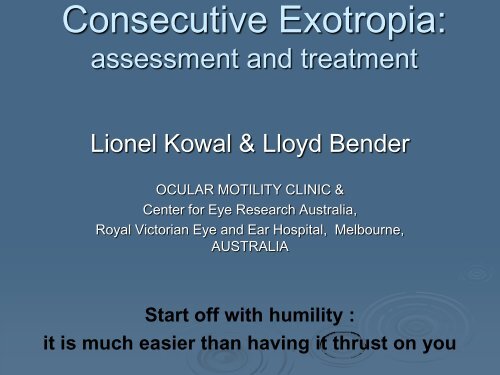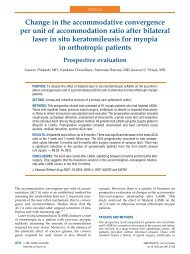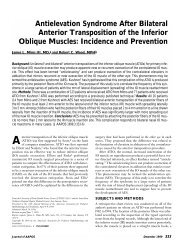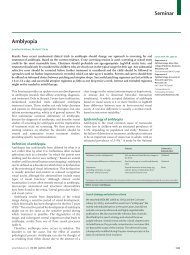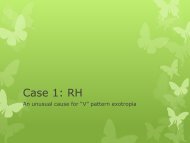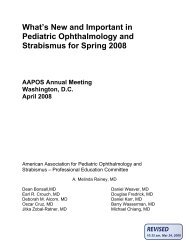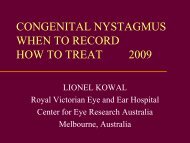Consecutive exotropia - The Private Eye Clinic
Consecutive exotropia - The Private Eye Clinic
Consecutive exotropia - The Private Eye Clinic
You also want an ePaper? Increase the reach of your titles
YUMPU automatically turns print PDFs into web optimized ePapers that Google loves.
<strong>Consecutive</strong> Exotropia:<br />
assessment and treatment<br />
Lionel Kowal & Lloyd Bender<br />
OCULAR MOTILITY CLINIC &<br />
Center for <strong>Eye</strong> Research Australia,<br />
Royal Victorian <strong>Eye</strong> and Ear Hospital, Melbourne,<br />
AUSTRALIA<br />
Start off with humility :<br />
it is much easier than having it thrust on you
CONSECUTIVE XT<br />
�Any XT happening after previous ET<br />
� Usually after ET surgery<br />
� Rare: spontaneous consecutive XT : was ET, no<br />
surgery - now XT<br />
Kowal MEACO 2009<br />
Old medial rectus<br />
Surgery<br />
2
HOW COMMON IS CONSEC XT?<br />
Alberto Ciancia [Argentina]:<br />
90% perfect early alignment<br />
after cong ET surgery [n=390]<br />
30% consec XT over next<br />
25y [50% followup]<br />
Kowal MEACO 2009<br />
3
Core defect in consec XT<br />
�… is Medial Rectus<br />
underaction<br />
�WHY / HOW do we get<br />
this MR underaction?<br />
Kowal MEACO 2009<br />
4
RETROSPECTIVE SERIES<br />
�All my patients with consecutive<br />
XT seen &/or operated in last 5y<br />
�A few had surgery earlier, but were<br />
seen in this period<br />
�225 patients seen<br />
�119 have surgery [~ 50%]<br />
Kowal MEACO 2009<br />
5
WHY DOES CONSEC XT<br />
� EARLY<br />
LATE:<br />
HAPPEN?<br />
� INSERTION MIGRATION<br />
� GENERIC<br />
� STRETCHED SCAR<br />
Kowal MEACO 2009<br />
6
1. Early consec XT n=9 [7.5%]<br />
WHY?<br />
�1: Poor suturing technique<br />
�2: Knots come undone<br />
�3: Aberrant early healing<br />
Kowal MEACO 2009<br />
7
1. Early consec XT :<br />
‘Slipped muscle’ ~2w after surgery<br />
CASE: Explore ‘slipped muscle’<br />
– no vicryl seen.<br />
Did the pt pull it out somehow?<br />
Was it faulty and it hydrolysed<br />
in 2 weeks?<br />
Kowal MEACO 2009<br />
8
50% of patients: 2 ND & 3 RD<br />
decades after last ET surgery<br />
MEDIAN TIME TO SURGERY 22 YRS. AVERAGE 23. Kowal MEACO 2009<br />
9
THIS IS AN ADULT DISEASE<br />
Kowal MEACO 2009<br />
10
45<br />
40<br />
35<br />
30<br />
25<br />
20<br />
15<br />
10<br />
5<br />
0<br />
Distribution of pre-op angle Δ<br />
70<br />
Kowal MEACO 2009<br />
11
2. Insertion migration n=11<br />
[9%]<br />
� If Dr X recesses a MR by 4mm, & if I was<br />
to photograph it* or explore it a week later<br />
it might be 4 +/- 1mm.<br />
� <strong>The</strong>re are artifacts in measurements, in<br />
how traction sutures or locking forceps pull<br />
on the limbus or insertion & stretch the<br />
sclera anterior or behind the insertion etc.<br />
so some small real or apparent<br />
“insertion migration” is expected.<br />
* PAT in ET study<br />
Kowal MEACO 2009<br />
12
Insertion migration<br />
� If I have good records [esp. my own] that<br />
show 5mm recess and I find the muscle<br />
13mm from limbus that‟s probably<br />
insertion migration.<br />
� Possible mechanism : Shifting the<br />
insertion might change the mechanical<br />
stresses on different parts of the sclera &<br />
have an effect on growth.<br />
Kowal MEACO 2009<br />
13
IRENE LUDWIG’S AOS THESIS<br />
Trans Am Ophthalmol Soc. 1999<br />
Kowal MEACO 2009<br />
14
Insertion migration<br />
�Total known cases 11 [=9%]<br />
�Total unrecognised cases ??<br />
Kowal MEACO 2009<br />
15
3. ‘GENERIC’ causes for consec XT<br />
?Wrong surgical dose for this case<br />
Surgical tables make MANY assumptions:<br />
� normal globe size<br />
bigger globe needs bigger surgery for same angular effect<br />
� normal globe shape<br />
prolate vs. oblate : egg-shaped – longer axis A-P or<br />
transverse<br />
� average muscle stiffness<br />
….many reasons why the ‘standard’ surgical<br />
dose may not be the best dose for this<br />
particular case<br />
Kowal MEACO 2009<br />
16
Surgical tables make MANY<br />
assumptions…<br />
�average scleral rigidity<br />
clearly varies with globe size and refraction<br />
�average mechanical response of<br />
antagonist<br />
must vary with initial stiffness<br />
….many reasons why the ‘standard’ surgical<br />
dose may not be the best dose for this<br />
particular case<br />
Kowal MEACO 2009<br />
17
<strong>The</strong> correct ET operation doesn‟t<br />
„grow‟ with the pt<br />
MR is repositioned to align the eyes &<br />
allow best early visual devpt<br />
Subsequent growth of<br />
globe, muscle, orbit & any insertion<br />
migration may alter this perfect<br />
mechanical ‘balance’<br />
mechanically disadvantage the<br />
repositioned MR<br />
Kowal MEACO 2009<br />
18
4. Delayed consec XT - WHY?<br />
„Stretched scar‟<br />
� look for stretchmarks, healing of other surgical<br />
scars, ….<br />
� Scar remodelling is an ongoing lifelong process<br />
� Scar is metabolically more active than tendon<br />
� Seminal papers by Ludwig, Irene H J AAPOS.<br />
2000 & Trans Am Ophthalmol Soc. 1999<br />
� Use non- absorbable sutures - recurrence of<br />
stretched scar<br />
Kowal MEACO 2009<br />
19
Scar remodeling after strabismus surgery<br />
Irene Ludwig, MD, Alan Chow, MD JAAPOS 4: 326-333; 2000<br />
“When we explored the … muscles of patients with<br />
such overcorrections, the expectation was that<br />
the muscles would be found normally healed at<br />
their original surgical attachment sites and that<br />
repositioning ….would repair the deviations.<br />
… many of the overcorrection cases<br />
demonstrated a segment of amorphous scar<br />
tissue separating the tendon from its<br />
attachment site on the sclera”<br />
.<br />
� Kowal MEACO 2009<br />
20
Scar remodeling after strabismus surgery<br />
Relative to all reoperation cases, lengthened<br />
scars were estimated to be found … in the<br />
subset of patients with late overcorrections, in<br />
about 50%. [LK series: 42%]<br />
� Mean time between original strabismus surgery<br />
and scar repair 122 mo (range 1-612 mo). [LK<br />
series: 307 mo]<br />
� Median age at time of repair 19 y (range 3-68 y)<br />
[LK series: 33 y, range 3-68y !].<br />
Kowal MEACO 2009<br />
21
Scar remodeling after strabismus surgery<br />
� <strong>The</strong> time course of the development of<br />
strabismus overcorrection was gradual in<br />
most cases, and overcorrection was not<br />
seen in any patients immediately after<br />
surgery, as would be expected with an<br />
improperly attached muscle.<br />
Kowal MEACO 2009<br />
22
How to recognise stretched scar<br />
Stretched scar<br />
Beige ‘meat’<br />
Kowal MEACO 2009<br />
Easily pulls off sclera<br />
Looks like muscle<br />
that has slipped in<br />
Its capsule, but<br />
the time<br />
course makes that<br />
impossible<br />
23
PRINCIPLES OF TREATMENT<br />
�Core defect in consec XT is<br />
Medial Rectus underaction<br />
�R x: Have to make MR function normal<br />
[or near- normal] for satisfactory long<br />
term result<br />
Kowal MEACO 2009<br />
24
#1 LMR UA<br />
L XT R 6/6, L 6/12 Previous L R-R<br />
L XT<br />
Kowal MEACO 2009<br />
LMR UA<br />
HAVE TO<br />
FIX THE<br />
LMR UA TO<br />
FIX THE<br />
L XT<br />
25
#2 RMR UA<br />
R XT R 6/12, L 6/6 Previous R R-R<br />
R XT<br />
IS IT RMR UA?<br />
OR<br />
IS IT TIGHT RLR?<br />
OR<br />
IS IT BOTH?<br />
Right Gaze<br />
LMR normal<br />
Kowal MEACO 2009<br />
TIGHT RLR FROM<br />
„CHRONIC XT‟ LOOKS<br />
THE SAME AS<br />
MR UA AND<br />
PRESUMED WEAK RMR.<br />
CAN ONLY<br />
DIFFERENTIATE AT<br />
SURGERY<br />
HAVE TO NORMALISE<br />
BOTH<br />
26
MR underaction and laterality of XT :<br />
Mechanical explanation not always the only one<br />
�Usually LMR UA L XT<br />
�If the R is sensorially<br />
‘superior’, RMR UA can<br />
drive a L XT<br />
Kowal MEACO 2009<br />
27
Cooper’s 1961 dictum: not a<br />
reliable guide<br />
R 6/6 L 6/12<br />
PREVIOUS BMR<br />
L XT<br />
MR UA<br />
L > R<br />
Kowal MEACO 2009<br />
RMR UA<br />
LMR UA<br />
28
1<br />
WILL NEED TO FIX<br />
THE CYCLOVERTICAL<br />
ANOMALY AS WELL<br />
#3 : L XT L>R MR UA<br />
‘A’ pattern SO OA OU<br />
L XT<br />
XT greater<br />
on downgaze<br />
‘A’ pattern<br />
Sup obl<br />
OA OU<br />
MR UA<br />
L > R<br />
2<br />
Kowal MEACO 2009<br />
3. RMR UA<br />
LMR UA<br />
29
<strong>The</strong>se are difficult cases<br />
� Careful complete assessment<br />
�Careful pt education : pt’s<br />
expectations need to be same as Dr’s<br />
expectations<br />
� 2nd opinions sensible<br />
Kowal MEACO 2009<br />
30
<strong>The</strong>se are difficult cases<br />
� Need to make MR function normal or<br />
XT will recur<br />
� Difficult to dissect out tendons<br />
� Muscle ‘meat’ can be 20+ mm from limbus<br />
� Adjustables often necessary<br />
� Fat may be present<br />
� NO surgical tables<br />
� Intra-op ‘spring back’ as a guide<br />
� Guide: Early ET ≥ 10 ∆<br />
Kowal MEACO 2009<br />
31
RESULTS THIS SERIES<br />
Great result D & N ≤ 10Δ<br />
OK result<br />
Ortho D&N<br />
One or both of<br />
D&N = 0<br />
D & N, one ≤10 Δ<br />
or both ≤ 20 Δ<br />
Not good enough Both D & N > 20 Δ<br />
or further surgery<br />
recommended<br />
4 : convergence excess<br />
n =75<br />
37<br />
51<br />
Kowal MEACO 2009<br />
63%<br />
31%<br />
43%<br />
29 24%<br />
12 10%<br />
32
No correlation between quality<br />
of result and:<br />
Size of preoperative angle of XT P= 0.21<br />
Putative mechanism of XT<br />
- stretched scar<br />
-Insertion migration<br />
- ‘generic’<br />
P=0.11<br />
Duration of postop follow-up P=0.19<br />
Kowal MEACO 2009<br />
33
LENGTH OF FOLLOWUP<br />
< 2 MONTHS 37%<br />
2-6 MONTHS 20%<br />
6-12 MONTHS 11%<br />
1-2 YEARS 14%<br />
> 2 YEARS 17%<br />
MOSTLY ADULT POPULATION - DON’T<br />
RETURN IF THEY DON’T NEED TO OR<br />
DON’T WANT TO<br />
Kowal MEACO 2009<br />
34
REPEAT SURGERIES :<br />
FOR ET<br />
�7 require SURGERY [6%]<br />
�10 require BOTOX [8%]<br />
Kowal MEACO 2009<br />
35
REPEAT SURGERIES :<br />
FOR XT<br />
�14 REQUIRE 2 ND SURGERY [12%]<br />
� 2 /14 REQUIRE 3 RD SURGERY FOR XT<br />
�12% REQUIRE >1 SURGERY<br />
Kowal MEACO 2009<br />
36
IMPERFECT RESULTS<br />
� 12%: 2 nd [or 3 rd ] surgery for XT<br />
� 6% : surgery for ET [some have botox 1st]<br />
�Σ 18% have second surgery<br />
� ..additional 6 [5%] have Botox for ET<br />
� 10% : still > 20Δ or have another reason<br />
for another surgery<br />
�2/3 STRAIGHTFORWARD COURSE<br />
Kowal MEACO 2009<br />
37
Pre-op diplopia prediction<br />
� <strong>The</strong>se pts have sensory adaptation for<br />
both ET & XT : troublesome persistent<br />
diplopia rare<br />
Highly reliable pre-op indicators of very low<br />
diplopia risk:<br />
� If prismatic simulation of surgical<br />
correction doesn’t � diplopia<br />
� Photos of aligned eyes with no diplopia<br />
Kowal MEACO 2009<br />
38
Diplopia : Special caution<br />
�Pt who had 1st surgery<br />
late<br />
�Sensorially less ‘flexible’<br />
�Paradoxical diplopia<br />
more common<br />
Kowal MEACO 2009<br />
39
RESULTS 1<br />
<strong>Consecutive</strong> <strong>exotropia</strong> surgery<br />
GOMEZ DE LIANO SANCHEZ et al Arch Soc Esp Oftalmol. 2001<br />
� Retrospective n= 30<br />
SURGICAL PLAN:<br />
� LR Rc OU for < 35 ∆<br />
� Advance 1-2 MR if > 35 ∆<br />
� 70%: ≤± 10∆ > 50% one surgery.<br />
Kowal MEACO 2009<br />
40
RESULTS 2<br />
� Donaldson MJ, Forrest MP, Gole GA<br />
Surgical management of consec XT<br />
J AAPOS. 2004 n=59.<br />
� S x : LR Rc, MR adv to original insertion<br />
� Time to XT S x mean 14y (4mo-47 y) LK 23y<br />
� Mean preop XT 32 ∆<br />
� Result ≤±10∆ : 71% @ final follow-up LK 63%<br />
� 66% : exodrift after surgery - mean 8 ∆<br />
Kowal MEACO 2009<br />
41
RESULTS 3<br />
Outcome of a surgical treatment protocol for late<br />
consecutive <strong>exotropia</strong> following bilateral medial<br />
rectus recession for esotropia.<br />
Mims JL 3rd, Wood RC. Binocul Vis Strabismus Q. 2004;19(4):201-6.<br />
� 119 children followed 6 mo - 15 y after surgery<br />
� LR recess 7 - 8.5mm if ≤ 23 ∆ XT<br />
� LR Rc & advancement of one previously<br />
recessed MR to the insertion if ≥ 24 ∆ XT.<br />
� <strong>The</strong> overall "success" rate for this protocol was<br />
74% at 2- 4 y postop'.<br />
Kowal MEACO 2009<br />
42
Spontaneous consec XT<br />
Alan Scott : unpublished series n= 19<br />
� ET ≤ 20 ∆ Onset ≤ 2y<br />
� ≥ + 4 DS Amblyopia ≥ 1 line<br />
� 12/19 : spontaneous consec XT<br />
� Only 4/19 stayed ET<br />
� ET usually declined ≥ age 5<br />
� “This set you don‟t want to touch surgically at an<br />
early age”<br />
� LK : 70 ET pts, ≥+6, 2003-5<br />
� 2/70 spontaneous consec XT<br />
� UNRECOGNISED SELECTION BIAS<br />
Kowal MEACO 2009<br />
43
Spontaneous consecutive XT<br />
� 2 cases of spontaneous consecutive XT<br />
� 2% of all consecutive XT<br />
� High +, amblyopia, cong ET<br />
� # 1 : 10 yo F, infantile ET<br />
� XT first noted ~ 2 yo<br />
� Now XT 10Δ with V<br />
� R +8.75, L +7.00<br />
� R amblyopia 6/12<br />
� No surgery<br />
Kowal MEACO 2009<br />
44
� # 2<br />
Spontaneous consec XT<br />
� 30 yo F<br />
� Infantile ET ? Age onset XT<br />
� RXT 35Δ<br />
� R +7.50, L +4.50<br />
� R 6/45<br />
� R Rc/ Rs : RET 7Δ<br />
Kowal MEACO 2009<br />
45
SUMMARY - CONSEC XT<br />
� Difficult to assess and operate<br />
� Common in a dedicated strabismus practice<br />
� Common in a cong ET population<br />
� Expect 2/3 to do very well<br />
� 10% do not do well<br />
Starting with humility is easier than<br />
having it thrust on you<br />
Kowal MEACO 2009<br />
46
Thank You<br />
Yarra River footbridge Kowal MEACO Melbourne 2009<br />
Australia47
Factors UNrelated to outcome<br />
�Hyperopia<br />
Previous audit: high + common<br />
�Amblyopia<br />
Kowal MEACO 2009<br />
48
Mean time between ET and XT<br />
surgery<br />
� for stretched scar group = 25.6 years<br />
(median 23)<br />
� ALL: MEDIAN TIME TO SURGERY 22<br />
YRS. AVERAGE 23.<br />
Kowal MEACO 2009<br />
49
Age distribution at time of XT surgery (Years)<br />
B<br />
80<br />
70<br />
60<br />
50<br />
40<br />
30<br />
20<br />
10<br />
0<br />
Kowal MEACO 2009<br />
50
12<br />
10<br />
8<br />
6<br />
4<br />
2<br />
0<br />
Age distribution (B) in years<br />
0 to10 11 to 20 21 to 30 31 to 40 41 to 50 51 to 60 61 to 70<br />
Kowal MEACO 2009<br />
51
120<br />
100<br />
80<br />
60<br />
40<br />
20<br />
0<br />
Distribution of Pre-op angle of deviation (prism dioptres)<br />
Kowal MEACO 2009<br />
52
Distribtion of pre-op angle (All)<br />
45<br />
40<br />
35<br />
30<br />
25<br />
20<br />
15<br />
10<br />
5<br />
0<br />
70<br />
Kowal MEACO 2009<br />
53
‘GENERIC’ CONSEC XT<br />
Kowal MEACO 2009<br />
54
STRETCHED SCAR : LK SERIES<br />
Kowal MEACO 2009<br />
55
STRETCHED SCAR: LUDWIG SERIES<br />
Ludwig: time to stretch. Kowal: time to surgery.<br />
Kowal MEACO 2009<br />
56
Stretched scar group<br />
� Mean time between ET and XT surgery for<br />
B group (including 5 with B + something<br />
else) = 25.6 years (median 23)<br />
� Age at time of XT surgery – Mean 35.5<br />
years<br />
� - median 33<br />
years<br />
� Range of ages at Xt Sx 3.3 to 68 years (ref<br />
graph slide 2<br />
Kowal MEACO 2009<br />
57


